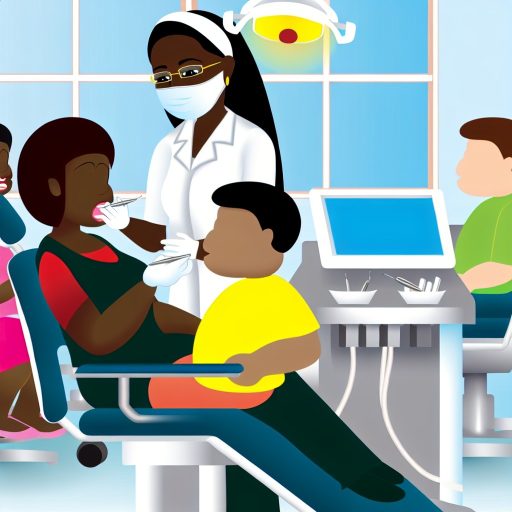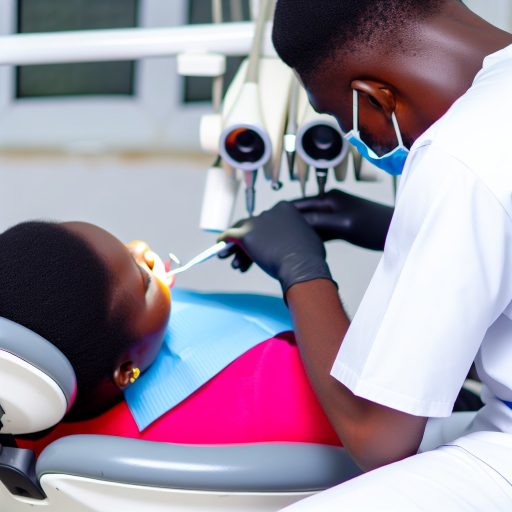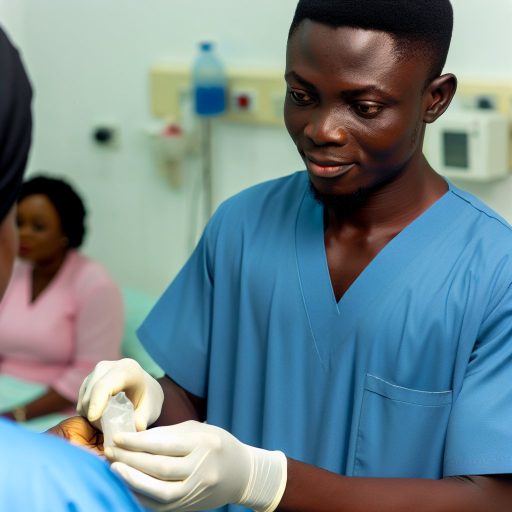Introduction:
Understanding anatomy is crucial for medical practice as it provides the foundational knowledge of the body’s structure and function.
In Nigeria, anatomy studies are conducted through dissection, cadaveric prosection, and radiographic imaging.
History of Anatomy Studies in Nigeria:
The study of anatomy in Nigeria has a rich history that dates back to the early days of medical education in the country.
- Introduction of Anatomy Studies:
- Evolution of Anatomy Studies:
- Key Milestones:
- Developments in the Field:
Anatomy studies were introduced in Nigeria in the early 20th century when the first medical schools were established.
Over the years, anatomy studies in Nigeria have evolved significantly, adapting to changes in medical practice.
Important milestones in the history of anatomy studies include the establishment of anatomy departments in medical schools.
The field of anatomy in Nigeria has witnessed developments in teaching methods, research, and technology.
In summary, the history of anatomy studies in Nigeria is characterized by growth, innovation, and a commitment to excellence in medical education.
Stay tuned for the next section to learn more about the impact of anatomy studies on Nigerian medical practice.
Curriculum and Training
Anatomy studies play a crucial role in shaping future healthcare professionals.
Let’s delve into the structure of anatomy studies and the training methods used in these institutions.
Structure of Anatomy Studies
Anatomy studies are typically structured into different courses throughout the medical curriculum.
These courses are designed to provide a comprehensive understanding of the human body’s structure, functions, and relationships.
Curriculum for Anatomy Studies
The curriculum for anatomy studies in Nigerian medical schools is carefully crafted to cover essential topics.
Topics include gross anatomy, histology, embryology, and neuroanatomy.
Students are introduced to these topics in a systematic and progressive manner.
Training Methods
To ensure effective learning, various training methods are employed in teaching anatomy.
These methods include lectures, laboratory sessions, dissections, prosections, computer-aided learning, and interactive multimedia resources.
Lectures
Lectures are a fundamental part of anatomy studies.
Students learn the theoretical aspects of the subject from experienced faculty members.
These sessions help students grasp complex anatomical concepts and principles.
Laboratory Sessions
Laboratory sessions provide students with hands-on experience in studying anatomical structures.
Through the use of anatomical models, specimens, and imaging techniques, students get a practical understanding of human anatomy.
Dissections and Prosections
Dissections and prosections involve the exploration and study of cadaveric specimens.
These practical sessions allow students to observe and dissect real human bodies, enhancing their understanding of anatomical structures.
Computer-Aided Learning
The use of technology in anatomy studies has revolutionized the learning process.
Computer-aided learning tools help students visualize complex structures in a more interactive way.
Interactive Multimedia Resources
Interactive multimedia resources are often used to supplement traditional teaching methods.
These resources offer students a dynamic learning experience and enable self-directed study.
Explore Further: Restorative Options for Missing Teeth
Impact on Medical Practice:
When it comes to the impact of anatomy studies on medical practice in Nigeria, it is crucial to examine how knowledge of anatomy influences the quality of healthcare delivery in the country.
Understanding the human body’s structure and function plays a significant role in improving diagnostic and surgical skills among healthcare professionals.
Enhancing Diagnostic Skills:
- Anatomy studies provide healthcare practitioners with a solid foundation of knowledge about the body’s structure.
- This knowledge helps medical professionals accurately locate and identify internal organs, tissues, and structures.
- By understanding anatomy, doctors can better interpret diagnostic imaging results such as X-rays, CT scans, and MRIs.
- Knowledge of anatomy allows healthcare providers to make more accurate diagnoses and treatment plans for patients.
Improving Surgical Skills:
- Anatomy studies are fundamental in preparing surgeons for intricate and complex surgical procedures.
- Surgeons rely on their knowledge of anatomy to navigate through the body’s various structures during surgery.
- Understanding anatomy helps surgeons minimize the risk of damaging surrounding tissues and organs during procedures.
- Knowledge of anatomical landmarks is crucial for accurate incisions and successful outcomes in surgeries.
Advancing Medical Research and Innovation:
- Anatomy studies provide a strong foundation for medical research and innovation in Nigeria.
- Researchers rely on anatomical knowledge to study disease pathology and develop new treatment modalities.
- Understanding the structural basis of diseases is essential for advancing medical science and finding new therapies.
- Anatomy studies contribute to the development of new surgical techniques and medical devices that improve patient outcomes.
Healthcare professionals in Nigeria must continue to prioritize anatomy education to ensure high-quality healthcare delivery and better patient outcomes.
Learn More: Understanding Mental Health Challenges in Nigeria
Research and Innovation:
Anatomy studies play a crucial role in driving medical research and innovation in Nigeria.
By exploring the intricate details of the human body, researchers are able to make significant advancements in various fields of medicine.
Here are some key ways in which anatomy studies contribute to research and innovation in Nigerian medical practice:
Advancements in Surgical Techniques:
- Anatomy studies provide surgeons with a deep understanding of the human body’s structure, allowing them to develop and refine surgical techniques.
- With this knowledge, Nigerian medical professionals have been able to perform complex surgeries with greater precision and success rates.
Development of Medical Devices:
- Researchers in Nigeria use their knowledge of anatomy to design and develop cutting-edge medical devices that improve patient care and outcomes.
- From prosthetic limbs to imaging technologies, anatomy studies serve as the foundation for innovative medical devices in the country.
Drug Discovery and Development:
- Understanding the human body’s anatomy is essential for the discovery and development of new drugs and treatment modalities in Nigeria.
- Researchers leverage their anatomical knowledge to identify drug targets and optimize treatment strategies for various diseases.
Groundbreaking Research in Anatomy:
- Nigerian researchers have conducted groundbreaking studies in the field of anatomy, shedding light on various aspects of the human body’s structure and function.
- From detailed anatomical atlases to innovative research on specific body systems, these studies have contributed significantly to medical knowledge in Nigeria.
Find Out More: Patient Financing Options for Dental Restorations
Challenges Faced in Anatomy Studies:
As essential as anatomy studies are in Nigerian medical practice, they come with their fair share of challenges and limitations.
Transform Your Career with Expert Guidance
Get personalized mentorship consulting that’s tailored to your unique path. Our expert advice is actionable and exclusive.
Get StartedThese hurdles often impede the learning and understanding of the intricate structures of the human body, which are crucial for medical professionals.
- Inadequate Resources: One of the primary challenges faced in anatomy studies is the lack of adequate resources.
- Outdated Curriculum: Another significant challenge is the outdated curriculum used in anatomy studies.
- Lack of Funding: The issue of insufficient funding also poses a challenge to anatomy studies in Nigeria.
- Inadequate Faculty: A shortage of experienced faculty members in anatomy departments can also be a challenge.
- Limited Practical Exposure: Due to constraints in resources and facilities, students may have limited hands-on practical exposure in anatomy studies.
Addressing these challenges in anatomy studies is crucial to ensure that medical professionals in Nigeria receive comprehensive and high-quality education in the field.
By overcoming these hurdles, students and professionals can enhance their understanding of human anatomy, ultimately improving the delivery of healthcare services in the country.
Gain More Insights: Career Paths in Radiological Science in Nigeria

Role of Anatomy Studies in Healthcare Delivery:
- Analyze the role of anatomy studies in improving healthcare delivery in Nigeria.
- Discuss how a strong foundation in anatomy leads to better patient outcomes.
Anatomy studies play a crucial role in healthcare delivery.
This knowledge provides healthcare professionals with a deep understanding of the structure and function of the human body.
This understanding is essential for diagnosing and treating various medical conditions effectively.
Let’s delve deeper into the importance of anatomy studies in Nigerian medical practice.
Enhanced Diagnostic Skills:
A strong background in anatomy equips healthcare providers with the necessary knowledge.
This knowledge helps them accurately interpret diagnostic imaging, such as X-rays and MRIs.
Understanding the location and function of organs and tissues allows for more precise diagnosis of medical conditions.
Improved Surgical Techniques:
Surgeons rely heavily on their anatomical knowledge when performing surgeries.
Understanding the intricate details of the human body’s anatomy is essential.
This knowledge ensures safe and successful surgical procedures.
Without it, the risk of complications during surgery significantly increases.
Effective Treatment Planning:
Healthcare professionals use their understanding of anatomy to develop personalized treatment plans for patients.
Knowing the location of specific structures within the body helps determine the most appropriate course of action.
This approach effectively addresses a patient’s health concerns.
Prevention of Medical Errors:
Anatomy studies also play a crucial role in preventing medical errors.
Healthcare providers who are well-versed in anatomy are less likely to make mistakes in patient care.
This leads to better patient outcomes by reducing medication administration errors and misdiagnoses.
Collaborative Healthcare Teams:
A solid foundation in anatomy fosters collaboration among healthcare professionals from different specialties.
When each team member has a comprehensive understanding of the human body’s structure, communication is enhanced.
This interdisciplinary approach leads to better healthcare delivery in Nigeria.
Continuing Education and Research:
Advancements in medical knowledge and technology require healthcare professionals to stay updated.
Anatomy studies serve as the foundation for ongoing learning.
This contributes to the development of innovative healthcare practices.
By staying abreast of new discoveries in anatomy, medical practitioners can continuously improve the quality of care.
Importance of Anatomy in Patient Outcomes
Anatomy studies are essential for improving healthcare delivery in Nigeria.
A profound understanding of the human body’s structure enables healthcare professionals to diagnose accurately.
This knowledge allows for safe surgeries and effective treatment planning.
It prevents errors, fosters effective collaboration, and keeps professionals current with advancements.
Investing in anatomy education is crucial for enhancing patient outcomes and advancing healthcare quality.
Future of Anatomy Studies in Nigeria:
In looking ahead at the future of anatomy studies in Nigeria, it is important to consider the potential trends and advancements that are likely to shape the field in the coming years.
Here are some predictions and opportunities for growth and development in anatomy studies:
Predicted Trends in Anatomy Studies:
- Increased integration of technology: As technology continues to advance, we can expect to see more interactive virtual anatomy labs and 3D imaging techniques being incorporated into medical education in Nigeria.
- Focus on clinical relevance: There will likely be a greater emphasis on teaching anatomy in the context of clinical practice, with a focus on how anatomical knowledge can be applied to diagnose and treat patients.
- Interdisciplinary collaboration: Anatomy studies in Nigeria are expected to become more interdisciplinary, with greater collaboration between anatomy departments and other medical specialties to enhance the learning experience.
- Globalization of education: With increasing globalization, there may be more opportunities for Nigerian medical students and researchers to collaborate with international institutions and participate in exchange programs to broaden their anatomical knowledge.
- Research and innovation: The future of anatomy studies in Nigeria will likely see an increase in research and innovation, with a focus on discovering new anatomical structures, functions, and potential applications in various medical fields.
Potential Opportunities for Growth and Development:
- Investment in infrastructure: One key opportunity for growth in anatomy studies in Nigeria is increased investment in modern anatomy labs, equipment, and resources to support innovative teaching and research.
- Professional development for educators: Providing opportunities for anatomy educators to enhance their teaching skills and stay current with advancements in the field will be crucial for the growth of anatomy studies in Nigeria.
- Collaboration with industry partners: Partnering with pharmaceutical companies, medical device manufacturers, and other industry stakeholders can provide valuable resources and support for anatomy studies in Nigeria, leading to new research opportunities and advancements.
- Community engagement: Engaging the local community through outreach programs, public lectures, and educational initiatives can help raise awareness about the importance of anatomy studies in healthcare and attract more students to the field.
- Global partnerships: Establishing partnerships with international universities and research institutions can open up new avenues for collaboration, exchange programs, and joint research projects that can contribute to the growth and development of anatomy studies in Nigeria.
The future of anatomy studies in Nigeria holds great promise, with opportunities for growth and development that can further enhance medical education and research in the country.
By staying abreast of current trends, investing in infrastructure and professional development, and fostering collaboration with industry partners and international institutions, Nigeria can continue to build a strong foundation for the study of anatomy and its impact on medical practice.
Anatomy’s Role in Medical Practice in Nigeria
Anatomy studies play a crucial role in shaping the medical practice in Nigeria.
Key Points:
- Understanding human anatomy is fundamental for medical professionals in diagnosing and treating patients effectively.
- Anatomy studies provide a solid foundation for medical students to comprehend the structure and function of the human body.
- Nigerian medical practice greatly benefits from anatomy studies by ensuring accurate clinical assessments and procedures.
- The knowledge gained from anatomy studies helps in avoiding medical errors and improving patient outcomes.
- Continuous emphasis on anatomy studies in medical education is essential for the growth and development of the healthcare system in Nigeria.
Significant Impact:
Anatomy studies not only enhance the skills and knowledge of healthcare providers but also contribute to the overall improvement of healthcare delivery in Nigeria.
The depth of understanding gained from studying anatomy is invaluable in ensuring that medical practitioners provide safe, effective, and ethical care to their patients.
Consequently, investing in anatomy studies is essential to maintain high standards of medical practice and enhance healthcare outcomes in Nigeria.
Additional Resources
Anatomical variations of the renal artery: a computerized …
Formal body bequest program in Nigerian medical schools: When …




